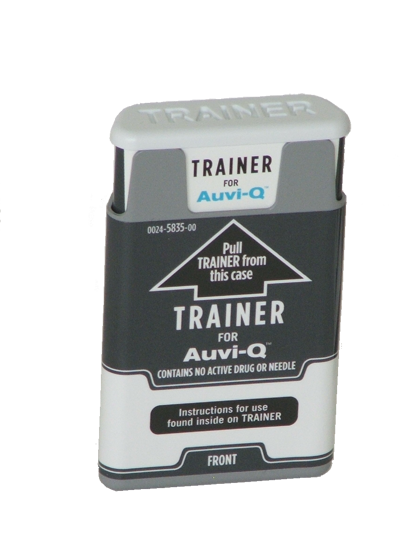AUVI-Q

ISSN-1059-6518 Volume 26 Number 3
A NEW PRODUCT FOR TREATING ANAPHYLAXIS
AUVI-Q
By Frank Hubbell, D.O.
INDICATIONS:
Auvi-Q is an autoinjector that contains epinephrine (adrenalin) for the use in severe Type 1 allergic reactions – anaphylaxis.
Epinephrine is a non-selective alpha and beta-adrenergic receptor agonist. The results of an IM or SC injection are bronchodilation, vasoconstriction, and an increase in heart rate.
An acute, severe Type 1 allergic reaction, anaphylaxis, is caused by too great a release of histamines, via degranulation from the MAST cells, resulting in bronchoconstriction, vasodilation, and an itchy, urticarial rash. Thus, epinephrine is the perfect drug to counteract the effects of the histamines.
Remember, that you are taking advantage of the side effects of epinephrine in counteracting the potentially life-threatening effects of the histamines. But, the effects of epinephrine only last 20 – 30 minutes and then the acute allergic reaction can return.
The cure for the over-abundance of histamines is to give an antihistamine. So, remember that regardless of how the epinephrine is administered, it has to be followed with an oral antihistamine such as Benadryl (diphenhydramine) 50 mg by mouth every 4 hours for 24 hours (Benadryl 50mg po q4h x 24h).
What makes Auvi-Q unique is that it speaks to the individual administering the autoinjector. Designed to fit in a pant’s pocket so when needed it is readily accessible. The cap is removed, and the autoinjector will then talk you through the process of giving the shot.
You can go on their website, auvi-q.com, and watch a demonstration of its use.
DOSAGE FORMS AND STRENGTHS:
Adult: greater than or equal to 30kg (66lbs)
0.3mg: 0.3mg/0.3ml of 1/1000 epinephrine.
Pediatric: 15 – 30kg (33 – 66lbs)
0.15mg: 0.15mg.0.15ml of 1/1000 epinephrine.
Contraindications:
NONE
WARNINGS AND PRECAUTIONS:

